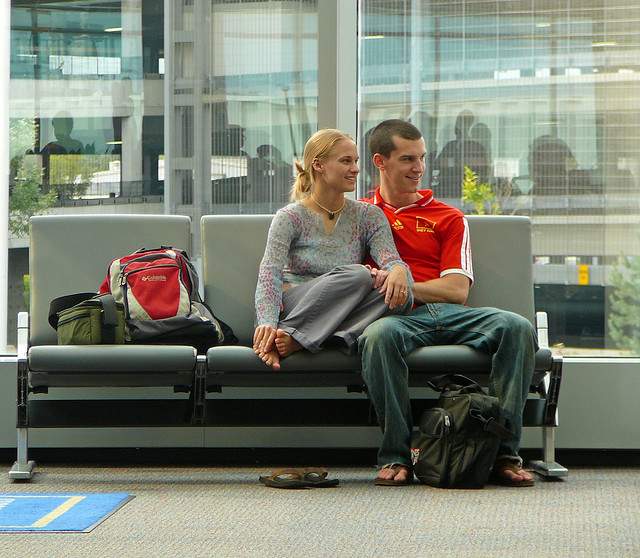Her: “That’s the sign for the ticket office.” Him: “No it isn’t, that’s the sign for the bar.”
No matter how long you have been with your significant other and how much you cuddle and kiss at home, hitting the road is a true test of any relationship. While exhilarating, travel can bring a lot of stress along the way. There have been countless posts, articles and forums addressing this topic; we’ve added four new ideas to round out your repertoire of strategies to smooth out too much “together time.”
Men and women are definitely from Mars and Venus on almost all things, especially when it comes to travel. Whether you are negotiating how to spend your day in Bangkok (she wants shopping, he wants boat cruise) or interpreting stick figure information signs in the Amsterdam train station, you’re each going to have your own opinion.
Tip #1: Think of Packing as a Team Sport
One benefit of traveling together is the ability to divide and conquer. Long before departure morning, get together with your significant other and create three packing lists: Yours, Mine and Ours. On each list, write down the items you will need personally (medication, etc.) and items you can share (toiletries, etc.).
A good strategy for a team approach if you can pull it off: One checked bag and two carry on bags. This way, you can put larger, heavier items and liquids in the checked bag and divide up other necessities into your two carry on bags. Each person carries their own essentials; don’t put anything in the checked bag you can’t replace.
Once you’ve consolidated the three lists, determine what goes in each bag. If you both wear contacts, determine who’s carrying the saline in their checked bag. If carry-on only is your goal, look at the toiletries you’ll need and how to make sure you get the maximum out of each person’s one-quart bag/3 oz rule limitations.
Tip #2: Plan Ahead to Avoid Snapping at Each Other on the Long, Long Road:
This is a particularly tough one if your travel involves extensive plane flights, transfers and jet lag. Everyone deals with travel stress differently. Remember, you’re a team and want to help the other person feel better (so they will do the same for you!). Some tips:
1. If you know your partner get cranky when their blood sugar gets low, put a few granola bars or bags of mixed nuts in your carry on – They are good for a boost of energy and will keep you feeling full until your next meal.
2. Know your own stress triggers. Does your back get very sore while sitting and put you in a foul mood? Drop some ibuprofen in your carry on to take when the pain begins to throb and you feel yourself wanting to snap at your sweetie.
3. Bring each other’s favorite things – This could be a game, book or other activity to keep yourselves busy.
4. Pace yourself. Realize that you may be a fast walker and your travel partner takes two strides for every one of yours. To avoid a fight, let the slower member of your team set the pace.
5. Once you get to where you’re going, your first step should be to try to feel physically better and refreshed as soon as possible – It will help you not get mad at each other. Take a hot or cool shower, grab something to eat and perhaps a drink – as soon as possible (before any sightseeing or other activities).
Tip #3: Set Guidelines for Your Morning Routines:
You’ve arrived at your destination – Congratulations! Even if you don’t live together back home, traveling on the road means sharing mornings. You may discover your partner is a grump without two cups of coffee and a good hour to wake up. This can be disconcerting if you are a bright eyed and bushy tailed morning person (note: non-morning people tend to be totally baffled by morning people).
What might be a mildly amusing difference back home becomes amplified into a potential argument point when you are sharing a tiny hotel room. To help remedy morning stress, agree on a routine beforehand that works for you. Some ideas:
— The morning person will wake up and quietly dress and do something before rousing the non-morning person (i.e. – Go get a cup of coffee, head to the gym or out for a walk, go read the paper, etc.)
— The non-morning person agrees to be at least out of bed and in the process of getting ready by the time the morning person returns
— Set a “go time”: The time you both agree you want to be on your way for the day
— Flip flop back and forth departure times: Some mornings you will be leaving a little earlier than you want, some days, a little later
Tip #4: Be Up Front About Bathroom Protocol:
This can be a real stress point for couples, particularly those not used to sharing bathroom time and space on a regular basis. Everyone has their own routine and another body throws those patterns off kilter.
If you’ve traveled outside the U.S., especially to developing or third-world countries, you know also that standards for bathroom construction and privacy can vary wildly. Even the closest of couples don’t want to necessarily experience first hand everything the other person is doing in the bathroom.
One potential solution here is to carve up bathroom time. Perhaps you need more time in the morning while your mate might want an extra long shower late in the evening.
Develop a system and communicate – give each other the heads up as to when you need the bathroom and when you might just enjoy extra time. This also holds true for grooming rituals. Guys, trust me, you most likely do not want to see your wife or girlfriend bleaching her upper lip or plucking her eyebrows. Ladies, do you really want to check out your man trimming his nose hair?
A good system is the closed door rule. If the door is closed completely, that means everyone else is persona non grata. No knocking, no asking when they will be done, no popping their head in to grab a towel or toothbrush. It may seem harsh, but creating a rule like this (or whatever signal works for you) will let each person maintain their own space and privacy without having to fight about it every time.
Some people also prefer the shared room time theory, where if one person really needs the bathroom for an extended period of time, the other person might just take a book to the balcony or grab a coffee downstairs to allow their travel partner quiet, uninterrupted time and not feel like they are holding the other person up. It sounds trivial, but countless travel quarrels emerge from bathroom turf battles and ground rules like this can avoid hurt feelings later.
Travel is one of the most rewarding experiences couples can do together; experiencing new cultures and people can bring you closer together and better appreciate your lives at home. With a bit of planning and cooperation, you can help avert bumps in the road and keep smiling off into the sunset!
Aimee Cebulski is a freelance writer based in San Diego, California. She has traveled to more than 39 countries and completed a round-the-world adventure with her boyfriend, cohabitating through Europe, Africa and Asia for six months. She is currently working on a book about women turning 40 worldwide called Finding Forty (www.finding40.net).
Photos by Ed Yourdon, MelvinShlubman, erlin1, OPUS Hotels



